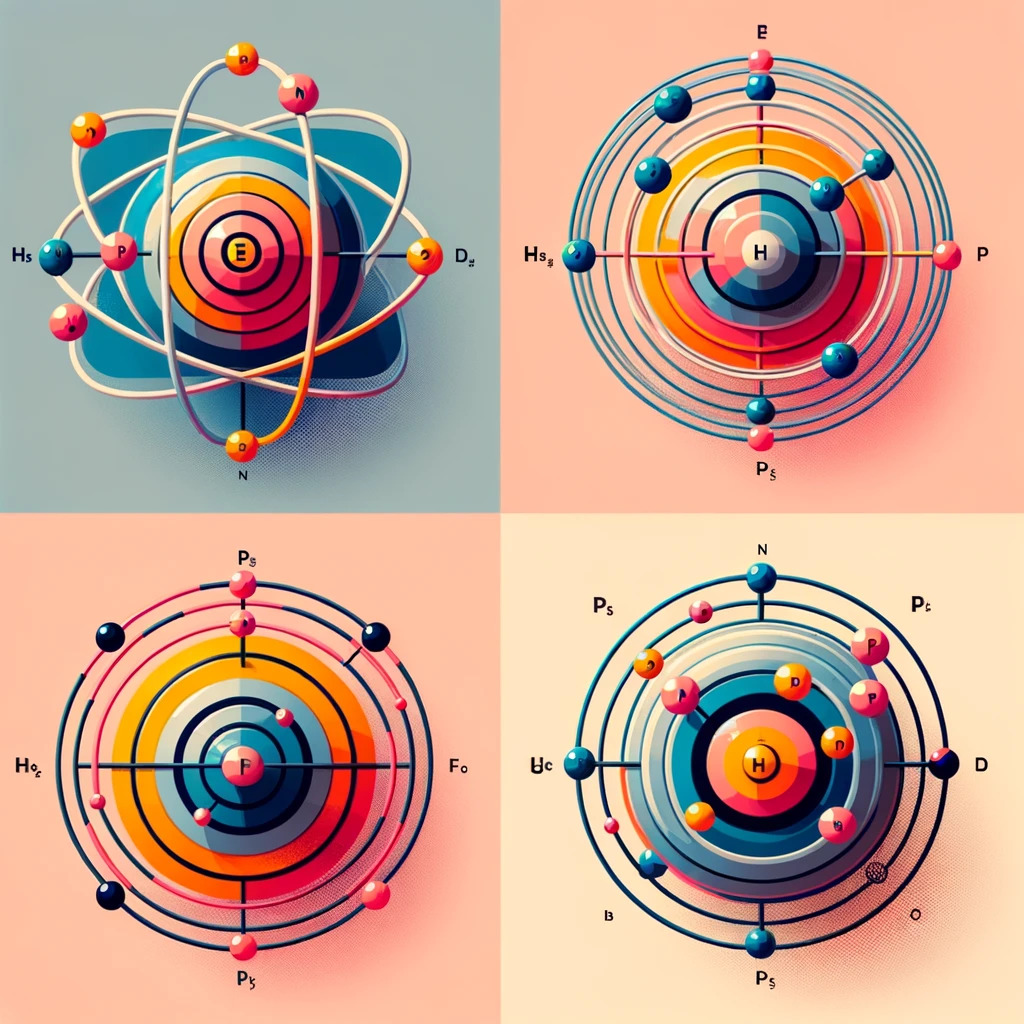
Have you ever considered why elements behave as they do? It’s all down to something called electronic configuration and atomic orbitals.
These concepts are crucial in understanding how atoms and molecules interact, form bonds, and react in chemical processes. This article will explain electronic configuration and atomic orbitals, how they’re determined, and why they’re so important in chemistry. Whether studying for a test or just curious about atomic behavior, this guide will help you understand all there is to know about electronic configuration.
Electronic Configuration and Atomic Orbitals: Key Takeaways
If you’re short on time, here are the essential points about electronic configuration and atomic orbitals:
🟠 Electronic Configuration is Fundamental: It describes the arrangement of electrons in an atom’s orbitals, crucial for understanding an element’s chemical behavior.
🟠 Orbital Shapes and Types Matter: The shapes of s, p, d, f orbitals and their placement in the periodic table influence how atoms bond and react.
🟠 Exceptions and Periodic Trends are Key: Understanding exceptions to electronic configuration and how electron arrangements influence periodic trends is vital in predicting element reactivity and chemical bonds.
Having a tough time grasping electronic configurations and atomic orbitals? No need to stress! You’ll find these concepts much easier to understand with one-on-one tutoring or dynamic chemistry lessons. And remember to check out our World of Chemistry blogs for more exciting topics to explore, all at no cost!
Electronic Configuration: Electron Arrangement in Atoms
Electronic configuration is crucial in chemistry. It’s a way to map out where an atom’s electrons are. This mapping tells us how atoms will interact with others.
Using the Periodic Table for Electronic Configuration
When you look at the periodic table, it’s not just a list of elements. It’s a map for understanding electronic configuration. Each element’s position on the table gives us clues about its electron arrangement.
For example, by looking at the rows and columns, you can find out how many electron shells an element has and how these shells are filled. This information helps predict how an element will react chemically. So, next time you see a periodic table, remember it’s a tool that helps us understand the atoms and their electrons.
Example 1: How to Write Electronic Configuration of Oxygen
Oxygen is in period 2, group 16. The electronic configuration of oxygen is 1s² 2s² 2p⁴.
This means oxygen has two electrons in the first shell (1s orbital) and six electrons in the second shell (2s and 2p orbitals).
Example 2: How to Write Electronic Configuration of Sodium
Sodium is in period 3, group 1. The electronic configuration of sodium is 1s² 2s² 2p⁶ 3s¹.
This means that sodium has two electrons in the first shell, eight electrons in the second shell, and one electron in the third shell.
Example 3: How to Write Electronic Configuration of Strontium
Strontium is in period 5, group 5. The electronic configuration of strontium is 1s² 2s² 2p⁶ 3s² 3p⁶ 4s² 3d¹⁰ 4p⁶ 5s².
This means that strontium has two electrons in the first shell, eight electrons in the second shell, 18 electrons in the third shell, eight electrons in the fourth shell, and two electrons in the fifth shell.
Principles of Electron Configuration: Aufbau, Pauli Exclusion, Hund’s Rules
Understanding electron configuration also means familiarizing with three fundamental rules: the Aufbau principle, the Pauli exclusion principle, and Hund’s rules. These rules work together to determine how electrons are arranged in an atom, affecting the atom’s chemical reactions and properties.
Key Principles of Electronic Configuration
- Aufbau Principle: Electrons first fill the lowest energy orbitals before moving to higher energy levels. Think of it like filling seats in a classroom from the front to the back.
- Pauli Exclusion Principle: No two electrons in an atom can have the same set of four quantum numbers. This means each electron in an atom has a unique place and spin direction.
- Hund’s Rule: Within a subshell, electrons prefer to occupy orbitals singly before pairing up. It’s similar to how people would first sit in empty rows in a theater before sharing a row.
Understanding Spectroscopic Notation and Quantum Numbers
Spectroscopic notation is a way to identify an electron’s position within an atom. It uses four quantum numbers to show the energy level, shape, orientation, and spin of the orbital where an electron is located.
These quantum numbers are:
- The principal quantum number: the energy level of the orbital.
- The azimuthal quantum number: s p d f orbitals.
- The magnetic quantum number: the orientation of the orbital—x, y, or z.
- The spin quantum number: the electron’s spin—up or down.
This notation gives the exact information about the orbital and its electron. Knowing this helps chemists understand how atoms share or exchange electrons and form bonds.
Are you finding these concepts tricky? Chemistry tutors provide personalized lessons tailored to your needs, making inorganic chemistry understandable and enjoyable.
Atomic Orbitals: Understanding Electron Probability Zones
Atomic orbitals are areas around an atom’s nucleus, likely housing electrons. Understanding these areas gives us insights into an atom’s behavior.
Shapes and Orientations of s, p, d, f Orbitals
Atomic orbitals are regions in an atom where electrons are most likely to be found. There are different types, mainly s, p, d, f orbitals. The s orbital is spherical, the p orbitals are dumbbell-shaped, the d orbitals are more complex, and the f orbitals are even more intricate. Each type has a unique shape and orientation, influencing how atoms bond and react. Understanding the shapes of s p d f orbitals helps you grasp why certain elements behave in specific ways.
Orbital Diagrams – Visualizing Electron Distributions
Orbital diagrams are like maps that show where electrons live in an atom. They help us visualize how electrons are distributed across different orbitals. In these diagrams, each orbital is represented by a box, and electrons are shown as arrows. The direction of the arrow indicates the electron’s spin. By looking at these diagrams, you can see how electrons fill the orbitals according to the Aufbau principle, Pauli exclusion principle, and Hund’s rules.
Example: Orbital diagram for Carbon
| n | s | p | d | f |
|---|---|---|---|---|
| 1 | ↑↓ | |||
| 2 | ↑↓ | ↑↑ | ||
| 3 | ||||
| 4 |
How to calculate molar mass, mass fraction, and viscosity?
SPDF Orbitals on the Periodic Table
The periodic table is more than just a list of elements. It also shows us how s p d f orbitals are filled with electrons. Each row on the table corresponds to a principal energy level filled with electrons. For instance, elements in the first two columns fill the ‘s’ orbitals, while those in the right-hand columns fill the ‘p’ orbitals. The transition metals fill the ‘d’ orbitals, and the lanthanides and actinides fill the ‘f’ orbitals. This organization helps explain why elements in the same column often have similar chemical properties and electron configurations.
Anyone curious about chemistry in daily life can explore simple experiments or consult a chemistry tutor to discover more about the science behind these everyday phenomena.
Exceptions to Electronic Configuration: Why Do They Happen?
Sometimes, atoms don’t stick to usual electronic configuration patterns. These exceptions are intriguing, shedding light on unique atomic behaviors.
Explaining Exceptions in Electron Configuration
In chemistry, rules are sometimes broken, which is true for electronic configuration. Usually, electrons fill orbitals in a predictable order. However, some elements don’t follow this order, leading to exceptions to the electronic configuration. Why does this happen?
It’s because these elements find a more stable arrangement by tweaking the usual filling order. An orbital diagram can help us understand these exceptions. For example, a single electron moves to a different orbital in chromium and copper, creating a more balanced and stable arrangement. This might seem small, but it significantly impacts the element’s chemical properties and reactivity.
Explore ethanol and alcohols in chemistry, fermentation, and how beer is made.
Electron Configuration and Periodic Trends and How They Relate
Electron configuration offers more than individual atom insights. It helps us understand broader periodic table trends, such as element reactivity.
Electron Configuration’s Impact on Chemical Properties
Electron configuration determines an element’s chemical properties. The number of electrons in the outermost shell influences how an element will bond with others. Elements with a full outer shell, like noble gases, are usually unreactive because they don’t need to gain or lose electrons. On the other hand, elements with just a few electrons in their outer shell, like alkali metals, are highly reactive. They are eager to lose these electrons to achieve a stable configuration. Electron configuration helps predict reactivity, bond types, and even the formation of molecules.
Example: Orbitals and Water Molecule (H₂O)
In water, the oxygen atom uses its p orbitals to form covalent bonds with hydrogen atoms. The bent shape of the water molecule is due to the arrangement of electrons in these p orbitals, demonstrating how orbital shapes influence molecular geometry and bonding.
Read all about the polymerase chain reaction or PCR.
Understanding Periodic Trends Through Electron Configuration
Periodic trends are patterns in the properties of elements across the periodic table, and electron configuration is a key to understanding these trends. For example, atomic radius, or the size of an atom, generally decreases across a period from left to right. This happens because more protons are added to the nucleus as you move across a period, pulling electrons closer.
Also, elements become more electronegative or more likely to attract electrons as you move across a period because their atomic radii are smaller, making it easier to attract electrons for bonding.
Understanding the way electron configuration influences these trends helps predict how elements form chemical bonds. For example, elements with similar electron configurations often form similar types of bonds.
Are you struggling to grasp chemistry? An organic chemistry tutor or hands-on organic chemistry lessons can make a big difference in turning these complex ideas into something you can easily understand and use.
All you need to know about vitamins and minerals.
Essential Tips for Learning Electronic Configuration and Atomic Orbitals
In this article, we’ve covered the essentials of electronic configuration and atomic orbitals. We learned how the periodic table helps us find electron arrangements and the importance of rules such as the Aufbau principle, Pauli exclusion principle, and Hund’s rules in determining these configurations. We explored the distinct orbital shapes of s, p, d, f orbitals and how orbital diagrams aid in visualizing electron distributions.
Suppose you’re on the lookout for a chemistry tutor. In that case, a simple search like “organic chemistry tutor Liverpool” or “inorganic chemistry teacher Edinburgh” on platforms like meet’n’learn can help you find the right private teacher.
Those who prefer group learning environments can easily find chemistry classes nearby by searching for “chemistry classes Leeds” or “chemistry lessons London” online, leading you to local schools or educational centers.
Frequently Asked Questions About Electronic Configuration and Atomic Orbitals
1. What is Electronic Configuration?
Electronic configuration is how electrons are arranged in an atom’s orbitals.
2. How Does the Periodic Table Help in Understanding Electronic Configuration?
The periodic table shows the order in which orbitals are filled with electrons.
3. What are the Key Principles Governing Electronic Configuration?
The Aufbau principle, Pauli exclusion principle, and Hund’s rules guide electron placement in orbitals.
4. Why are Orbital Shapes Important in Chemistry?
Orbital shapes determine how atoms bond and react.
5. What Do Orbital Diagrams Represent?
Orbital diagrams visually represent the distribution of electrons in an atom.
6. How Can One Identify s, p, d, f Orbitals on the Periodic Table?
S p d f orbitals on the periodic table are identified by the element’s position and electron configuration.
Need help with biology topics? Explore our extensive collection of biology educational blog posts designed to simplify complex concepts for you. Whether it’s photosynthesis, osmosis, hypertonic solutions, the intricacies of green algae, understanding bacteria and viruses, or delving into the fascinating world of genetics and cells, our resources have got you covered. Expand your knowledge!
References:
1. Britannica
2. LibreTexts Chemistry
3. Wikipedia



